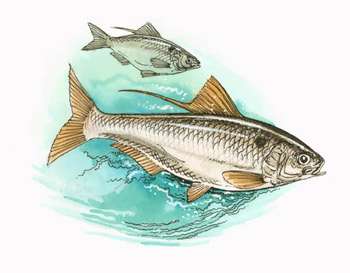
"If you wish to learn the highest truths, begin with the alphabet."
—Japanese proverb
To fully understand something, bass in this case, you must also understand the things around it, like what it eats, where it lives and its behavior. Since we try to get bass to eat something, knowing everything about them is imperative in giving a realistic presentation.
Match up
Shad are maybe the best known bass forage, with myriad lures imitating them. The two most popular species are gizzard shad and threadfin shad. While they are very similar, there are a few key differences worth noting to successfully use shad baits.
Gizzard shad are the heartier and more pervasive of the two; they can handle all but the most frigid waters, whereas threadfins will die in water below 40 degrees. With the occasional power plant lake as the exception, threadfins will typically not be found farther north than Interstate 40, which runs from North Carolina to southern California, says Central Region Supervisor for Oklahoma Department of Wildlife Conservation Gene Gilliland. Both are prevalent in Southern reservoirs and natural lakes.
When full grown, gizzards can reach 16 inches and weigh several pounds, where the biggest threadfins are no longer than six inches. Both species are similarly colored: a grey back with a white belly. Gilliland also notes that some shad may get purple or green coloration on their backs. This explains the vast array of "shad" colored baits.
Habits and haunts
Shad, like sunfishes, have co-evolved with bass for ages. They spawn in the late spring, just after the bass, providing
prime forage for fingerling bass. They do not make nests; rather they find flooded vegetation or wood as breeding grounds.
"The fish school up in shallow water and females release eggs in the water to be fertilized," Gilliland says. "The mating school will attract bass to really shallow water as it makes a lot of commotion."
Where they are abundant, shad are the primary forage in a given lake. Because bass are opportunistic feeders, they will naturally eat the most prevalent bait. Shad can account for up to 75 percent of a bass' diet when they are the main baitfish. Gizzards will eat detritus off the lake bottom when mature and can grow very quickly, while threadfin are pelagic, roaming open water feeding on plankton. When deep cranking points, you're probably going to get bit by fish eating gizzards, and when there are fish shallow or on top, it will usually be threadfins the bass are after.
Shad fishing strategies
Gilliland says that there a lot of good shad-imitating baits on the market, but the best are crankbaits and spinnerbaits. Shad colored crankbaits are hard to beat, and an appropriately colored spinnerbait appears to be a small school of them.
"When you're looking for good shad baits, you can't go wrong with silver or chrome-colored crankbaits," he says. "Spinnerbaits are good, too; just be sure to match the blade to the average size shad in your lake."
He also mentions a peculiar habit bass sometimes display which he calls "feeding tunnel vision." There are times
when bass will only eat bait that falls within a certain size range, and nothing else. Gilliland says that if the bass are only eating two-inch shad, a four-incher is fairly safe within the school being attacked. This can explain why you may not get bit when a school of shad is being busted by bass, either on top or underwater.
"When they're hitting on top and get tunnel vision, start by throwing a Zara Spook size bait to see if they take it," he says. "If not, then keep downsizing until you find the size they want."
The same applies for crankbaits; start large and then downsize until you find the right size. Once again, silver and chrome are always good choices, but in murky water adding chartreuse is beneficial because it lets the bass see the lure better.
"Even though they don't look like a shad with the bright colors, the bass will still hit it," he says. "Bass are less discerning in darker water; they don't 'think' about whether the fins and scales are in the right place or if it's the right color, they just eat."
Chances are that shad are on the menu in your lake, and ignoring them is leaving fish on the table. Learning their habits and understanding their relationship with bass is vital to successful angling with shad baits.




